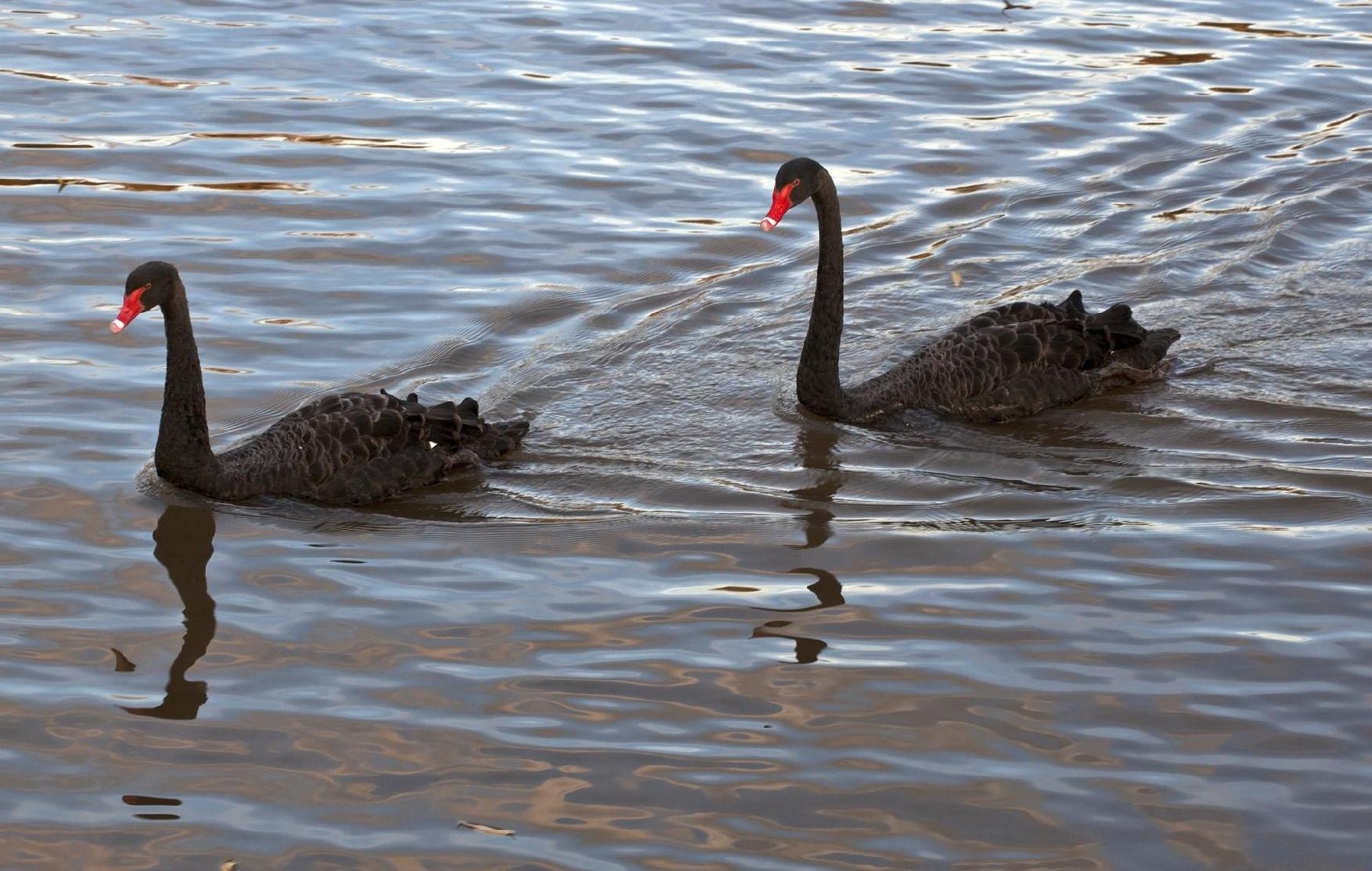Black Swan
A species of True Swans Scientific name : Cygnus atratus Genus : True Swans
Black Swan, A species of True Swans
Botanical name: Cygnus atratus
Genus: True Swans
Content
Description People often ask General Info
 Photo By Sheba_Also 43,000 photos , used under CC-BY-SA-2.0 /Cropped and compressed from original
Photo By Sheba_Also 43,000 photos , used under CC-BY-SA-2.0 /Cropped and compressed from original Description
Black swans are mostly black-feathered birds, with white flight feathers. The bill is bright red, with a pale bar and tip; and legs and feet are greyish-black. Cobs (males) are slightly larger than pens (females), with a longer and straighter bill. Cygnets (immature birds) are a greyish-brown with pale-edged feathers. A mature black swan measures between 110 and 142 centimetres (43 and 56 in) in length and weighs 3.7–9 kilograms (8.2–19.8 lb). Its wing span is between 1.6 and 2 metres (5.2 and 6.6 ft). The neck is long (relatively the longest neck among the swans) and curved in an "S"-shape. The black swan utters a musical and far reaching bugle-like sound, called either on the water or in flight, as well as a range of softer crooning notes. It can also whistle, especially when disturbed while breeding and nesting. When swimming, black swans hold their necks arched or erect and often carry their feathers or wings raised in an aggressive display. In flight, a wedge of black swans will form as a line or a V, with the individual birds flying strongly with undulating long necks, making whistling sounds with their wings and baying, bugling or trumpeting calls. The black swan is unlike any other Australian bird, although in poor light and at long range it may be confused with a magpie goose in flight. However, the black swan can be distinguished by its much longer neck and slower wing beat. One captive population of black swans in Lakeland, Florida has produced a few individuals which are a light mottled grey colour instead of black. 
Size
1.4 m
Life Expectancy
20 years
Nest Placement
Ground
Feeding Habits
Black Swan primarily consume aquatic vegetation, including algae, pondweeds, and shoots. They forage by dabbling or up-ending in water and occasionally eat insects, crustaceans, and molluscs. Black Swan are adapted to a largely herbivorous diet, favoring wetland habitats.
Habitat
Black Swan primarily inhabit shallow wetlands, both permanent and ephemeral, preferring fresh or brackish water environments such as lakes, lagoons, and billabongs. Ideal breeding grounds feature soft vegetation on islands or amongst tall flora. They are adaptable and can also frequent rivers, flooded fields, and coastal regions, with a penchant for permanent saline wetlands when available. Access to aquatic flora and soft herbage is vital for their sustenance across these habitats.
Dite type
Herbivorous
People often ask
General Info
Feeding Habits
Bird food type
Distribution Area
The black swan is common in the wetlands of southwestern and eastern Australia and adjacent coastal islands. In the south west the range encompasses an area between North West Cape, Cape Leeuwin and Eucla; while in the east it covers a large region bounded by the Atherton Tableland, the Eyre Peninsula and Tasmania, with the Murray Darling Basin supporting very large populations of black swans. It is uncommon in central and northern Australia. The black swan's preferred habitat extends across fresh, brackish and salt water lakes, swamps and rivers with underwater and emergent vegetation for food and nesting materials. Permanent wetlands are preferred, including ornamental lakes, but black swans can also be found in flooded pastures and tidal mudflats, and occasionally on the open sea near islands or the shore. Black swans were once thought to be sedentary, but the species is now known to be highly nomadic. There is no set migratory pattern, but rather opportunistic responses to either rainfall or drought. In high rainfall years, emigration occurs from the south west and south east into the interior, with a reverse migration to these heartlands in drier years. When rain does fall in the arid central regions, black swans will migrate to these areas to nest and raise their young. However, should dry conditions return before the young have been raised, the adult birds will abandon the nests and their eggs or cygnets and return to wetter areas. Black swans, like many other water fowl, lose all their flight feathers at once when they moult after breeding and they are unable to fly for about a month. During this time they will usually settle on large, open waters for safety. The species has a large range, with figures between one and ten million km given as the extent of occurrence. The current global population is estimated to be up to 500,000 individuals. No threat of extinction or significant decline in population has been identified with this numerous and widespread bird. Black swans were first seen by Europeans in 1697, when Willem de Vlamingh's expedition explored the Swan River, Western Australia. 
Species Status
The black swan is protected in New South Wales, Australia under the National Parks and Wildlife Act 1974 (s.5). It is evaluated as Least Concern on the IUCN Red List of Threatened Species. 